Estimation of Forest Aboveground Biomass in Karst Areas Using Multi-Source Remote Sensing Data and the K-DBN Algorithm
Abstract
:1. Introduction
2. Data and Material
2.1. Research Area
2.2. Data
2.2.1. The Ground Survey Data
2.2.2. Image Data
3. Technical Approach
3.1. Research Workflow
3.2. Feature Extraction
3.3. FCD Calculation
3.4. The Linear Regression (LR) and Random Forest (RF) Model
3.5. DBN Model Construction
3.5.1. DBN Structure
3.5.2. DBN AGB Mapping Workflow
3.5.3. K-DBN Model Construction
4. Results and Analysis
4.1. Performance of AGB Estimation Model
4.1.1. DBN Model Building
4.1.2. Model Accuracy Comparison
4.2. K-Value Setting of the K-DBN Model
4.3. K-DBN Model Performance
4.4. The AGB Spatial Mapping
5. Discussion
5.1. DBN Model Mechanism
5.2. K-DBN Alleviate the Overestimation and Underestimation
6. Conclusions
Author Contributions
Funding
Data Availability Statement
Conflicts of Interest
Appendix A
| Forest Type | Division Criteria | Dominant Tree SPECIES group |
|---|---|---|
| BLF | Broad-leaved pure forest (single broad-leaved tree stock ≥65%) and broad-leaved mixed forest (total broad-leaved tree stock ≥65%) | Birch, sweetgum, eucalyptus, Robinia pseudoacacia, locust, alamo, Paulownia, camphor tree, Camphora officinarum, other broad-leaved trees |
| CCF | Coniferous pure forest (single coniferous tree stock ≥65%) and coniferous mixed forest (total coniferous tree stock ≥65%) | Pinus armandi, cedarwood, Keteleeria fortunei, Pinus yunnanensis, Cryptomeria fortunei, masson pine, metasequoia, and other pine trees |
| MXF | Coniferous and broad-leaved mixed forest (the total volume of coniferous or broad-leaved trees accounts for 35~65%) | Coniferous and broad-leaved trees |
Appendix B
| Variable Type | Variation Number | Variable Name | Spectral Bands and Vegetation Indices | Formula | |
|---|---|---|---|---|---|
| Reflectance | 6 | Bands | Red, Green, Blue, NIR, SWIR1, and SWIR2 | ||
| Vegetation Index | 30 | ARVI | Atmospherically Resistant Vegetation Index | Huete, et al. [77] | |
| CVI | Chlorophyll II Vegetation Index | Vincini, et al. [78] | |||
| DVI | Difference Vegetation Index | Tucker, et al. [79] | |||
| EVI | Enhanced Vegetation Index | Huete, et al. [80] | |||
| GARI | Green Atmospherically Resistant Index | Gitrlson, et al. [81] | |||
| GDVI | Green Difference Vegetation Index | Wu, et al. [82] | |||
| GNDVI | Green Normalized Difference Vegetation Index | Gitelson, et al. [83] | |||
| GRVI | Green Ration Vegetation Index | -1 | Sripada, et al. [84] | ||
| GSAVI | Green Soil Adjusted Vegetation Index | Sripada, et al. [85] | |||
| IPVI | Infrared Percentage Vegetation Index | /(NIR+Red) | Crippen, et al. [86] | ||
| LAI | Leaf Area Index | Boegh, et al. [87] | |||
| MSRI | Modified Simple Ration Index | Chen, et al. [88] | |||
| MSAVI2 | Modified Soil Adjusted Vegetation Index 2 | Qi, et al. [89] | |||
| NDVI | Normalized Difference Vegetation Index | Huete, et al. [80] | |||
| NLI | Non-Linear Vegetation Index | Geol, et al. [90] | |||
| OSAVI | Optimized l Adjusted Vegetation Index | Rondeaux, et al. [91] | |||
| RDVI | Renormalized Difference Vegetation Index | Roujean, et al. [92] | |||
| RVI | Ratio Vegetation Index | Towers, et al. [93] | |||
| SAVI | Soil Adjusted Vegetation Index | Jordan, et al. [94], Huete, et al. [95] | |||
| SLAVI | Specific Leaf Area Vegetation Index | Huete, et al. [95] | |||
| SR | Simple Ratio Index SR | Birth, et al. [96], Colombo, et al. [97] | |||
| TCA | Tasseled Cap Angle | Powell, et al. [98] | |||
| TCD | Tasseled Cap Distance | Duane, et al. [99] | |||
| TCDI | Tasseled Cap Disturbance Index | Healey, et al. [100] | |||
| TGI | Triangular Greenness Index | Hunt, et al. [101,102] | |||
| VARI | Visible Atmospherically Resistant Index | Gitelson, et al. [103] | |||
| TCW | Tasseled Cap Wetness | 0.1446TM1 + 0.1761TM2 + 0.3322TM3 + 0.3396TM4 − 0.6210TM5 − 0.4186TM7 | Price, et al. [104] | ||
| TCG | Tasseled Cap Greenness | 0.2728TM1 − 0.2174TM2 − 0.5508TM3 + 0.7221TM4 + 0.0733TM5 − 0.1648TM7 | Rogan, et al. [105] | ||
| TCB | Tasseled Cap Brightness | 0.2909TM1 + 0.2493TM2 + 0.4806TM3 + 0.5568TM4 + 0.4438TM5 + 0.1706TM7 | Luneetta, et al. [106], Price, et al. [104] | ||
| TDVI | Transformed Difference Vegetation Index | Bannari, et al. [107] | |||
| Texture feature | 144 | GLCM | Gray-level co-occurrence matrix (CON, DIS, AVG, IDM, ENT, ASM, VAR, and COR) | (Contrast, dissimilarity, sum average, inverse difference moment, entropy, angle second moment, variance, and correlation) (window sizes of 3 × 3, 5 × 5, and 7 × 7 pixels) | |
| Sentinel-1A | 2 | Bands | VV and VH | ||
| 48 | GLCM | Gray-level co-occurrence matrix (CON, DIS, AVG, IDM, ENT, ASM, VAR, and COR) | (Contrast, dissimilarity, sum average, inverse difference moment, entropy, angle second moment, variance, and correlation) |
References
- Fang, J.; Chen, A.; Peng, C.; Zhao, S.; Ci, L. Changes in Forest Biomass Carbon Storage in China Between 1949 and 1998. Science 2001, 292, 2320–2322. [Google Scholar] [CrossRef] [PubMed]
- Tang, X.G.; Li, D.W.; Wang, Z.M. Research progress of Forest Aboveground Biomass Estimation by remote sensing. Chin. J. Ecol. 2012, 31, 1311–1318. [Google Scholar]
- Zhang, Z.; Tian, X.; Chen, E.X. Review on estimation methods of Forest Aboveground Biomass. J. Beijing For. Univ. 2011, 33, 144–150. [Google Scholar]
- Kauppi, P.E.; Mielikainen, K.; Kuusela, K. Biomass and Carbon Budget of European Forests, 1971 to 1990. Science 1992, 256, 70–74. [Google Scholar] [CrossRef] [Green Version]
- Brown, S. Measuring carbon in forests: Current status and future challenges. Environ. Pollut. 2002, 116, 363–372. [Google Scholar] [CrossRef]
- Li, D.R.; Wang, C.W.; Hu, Y.M. Research progress of forest biomass estimation by remote sensing technology. Geomat. Inf. Sci. Wuhan Univ. 2012, 37, 631–635. [Google Scholar]
- Brown, S.; Sathaye, J.; Cannell, M. Mitigation of Carbon Emissions to the Atmosphere by Forest Management. Commonw. For. Rev. 1996, 75, 80–91. [Google Scholar]
- Xu, X.L.; Cao, M.K.; Li, K.R. Temporal and spatial dynamics of vegetation carbon storage in forest ecosystem in China. Prog. Geogr. 2007, 26, 1–10. [Google Scholar]
- Lu, D.; Batistella, M.; Moran, E. Satellite Estimation of Aboveground Biomass and Impacts of Forest Stand Structure. Photogramm. Eng. Remote Sens. 2005, 71, 967–974. [Google Scholar] [CrossRef] [Green Version]
- He, Q.; Chen, E.; An, R.; Li, Y. Above-Ground Biomass and Biomass Components Estimation Using LiDAR Data in a Coniferous Forest. Forests 2013, 4, 984–1002. [Google Scholar] [CrossRef] [Green Version]
- Allouis, T.; Durrieu, S.; Vega, C.; Couteron, P. Stem volume and above-ground biomass estimation of individual pine trees from LiDAR Data: Contribution of full-waveform signals. IEEE J. Sel. Top. Appl. Earth Obs. Remote Sens. 2013, 6, 924–934. [Google Scholar] [CrossRef]
- Zhao, J.; He, Y.J.; Li, Z.K. Sustainable forest management strategy in China under the background of low carbon economy. World For. Res. 2012, 25, 1–5. [Google Scholar]
- Sarker, M.L.; Nichol, J.; Iz, H.B. Forest biomass estimation using texture measurements of high-resolution dual-polarization C-Band SAR Data J. IEEE Trans. Geosci. Remote Sens. 2013, 51, 3371–3384. [Google Scholar] [CrossRef]
- Li, Y.; Li, C.; Li, M.; Liu, Z. Influence of Variable Selection and Forest Type on Forest Aboveground Biomass Estimation Using Machine Learning Algorithms. Forests 2019, 10, 1073. [Google Scholar] [CrossRef] [Green Version]
- Houghton, R.A.; Hall, F.; Goetz, S.J. Importance of Biomass in the Global Carbon Cycle. J. Geophys. Res. Bio Geosci. 2009, 114, 935. [Google Scholar] [CrossRef]
- Liu, Q.; Yang, L.; Liu, Q.H.; Li, J. Review on remote sensing retrieval methods of Forest Aboveground Biomass. J. Remote. Sens. 2015, 19, 62–74. [Google Scholar]
- Crosby, M.K.; Matney, T.G.; Schultz, E.B.; Evans, D.L.; Grebner, D.L.; Londo, H.A.; Rodgers, J.C.; Collins, C.A. Consequences of Landsat Image Strata Classification Errors on Bias and Variance of Inventory Estimates: A Forest Inventory Case Study. IEEE J. Sel. Top. Appl. Earth Obs. Remote Sens. 2017, 10, 243–251. [Google Scholar] [CrossRef]
- Yang, W.Z.; Zhao, P.X.; Xue, D.Q. Study on forest biomass estimation model of Nanbei mountain in Xining City Based on landsat-8 image. J. Northwest For. Univ. 2016, 31, 33–37. [Google Scholar] [CrossRef]
- Xu, T.; Cao, L.; Shen, G.H. Optimal extraction of characteristic variables and forest biomass inversion based on Landsat 8 OLI. Remote. Sens. Technol. Appl. 2015, 30, 226–234. [Google Scholar]
- Lu, C.; Zhang, J.L.; Wang, A.Y.; Jiang, S.C.; Huang, C.X.; Luo, Y.J. Biomass estimation and reconstruction of Pinus Takayama in Shangri La based on Landsat TM. For. Inventory Plan. 2016, 41, 1–7. [Google Scholar]
- Li, C.; Li, Y.; Li, M. Improving Forest Aboveground Biomass (AGB) Estimation by Incorporating Crown Density and Using Landsat 8 OLI Images of a Subtropical Forest in Western Hunan in Central China. Forests 2019, 10, 104. [Google Scholar] [CrossRef] [Green Version]
- Joshi, C.; De Leeuw, J.; Skidmore, A.K.; van Duren, I.C.; van Oosten, H. Remotely sensed estimation of forest canopy density: A comparison of the performance of four methods. Int. J. Appl. Earth Obs. Geoinf. 2006, 8, 84–95. [Google Scholar] [CrossRef]
- Ou, G.; Li, C.; Lv, Y.; Wei, A.; Xiong, H.; Xu, H.; Wang, G. Improving aboveground biomass estimation of pinus densata forests in yunnan using landsat 8 imagery by incorporating age dummy variable and method comparison. Remote Sens. 2019, 11, 738. [Google Scholar] [CrossRef] [Green Version]
- Tigges, J.; Churkina, G.; Lakes, T. Modeling above-ground carbon storage: A remote sensing approach to derive individual tree species information in urban settings. Urban Ecosyst. 2016, 20, 97–111. [Google Scholar] [CrossRef]
- Mermoz, S.; Réjou-Méchain, M.; Villard, L.; Le Toan, T.; Rossi, V.; Gourlet-Fleury, S. Decrease of L-band SAR backscatter with biomass of dense forests. Remote. Sens. Environ. 2015, 159, 307–317. [Google Scholar] [CrossRef]
- Kumar, S.; Khati, U.G.; Chandola, S.; Agrawal, S.; Kushwaha, S.P. Polarimetric SAR Interferometry based modeling for tree height and aboveground biomass retrieval in a tropical deciduous forest. Adv. Space Res. 2017, 60, 571–586. [Google Scholar] [CrossRef]
- Santi, E.; Paloscia, S.; Pettinato, S.; Fontanelli, G.; Mura, M.; Zolli, C.; Maselli, F.; Chiesi, M.; Bottai, L.; Chirici, G. The potential of multifrequency SAR images for estimating forest biomass in Mediterranean areas. Remote Sens. Environ. 2017, 200, 63–73. [Google Scholar] [CrossRef]
- Benson, M.L.; Pierce, L.; Bergen, K.; Sarabandi, K. Model-Based Estimation of Forest Canopy Height and Biomass in the Canadian Boreal Forest Using Radar, LiDAR, and Optical Remote Sensing. IEEE Trans. Geosci. Remote Sens. 2010, 59, 4635–4653. [Google Scholar] [CrossRef]
- Zhu, Y.; Feng, Z.; Lu, J.; Liu, J. Estimation of Forest Biomass in Beijing (China) Using Multisource Remote Sensing and Forest Inventory Data. Forests 2020, 11, 163. [Google Scholar] [CrossRef] [Green Version]
- Chen, L.; Wang, Y.; Ren, C.; Zhang, B.; Wang, Z. Optimal combination of predictors and algorithms for forest above-ground biomass mapping from sentinel and SRTM data. Remote Sens. 2019, 11, 414. [Google Scholar] [CrossRef] [Green Version]
- Laurin, G.V.; Pirotti, F.; Callegari, M.; Chen, Q.; Cuozzo, G.; Lingua, E.; Notarnicola, C.; Papale, D. Potential of ALOS2 and NDVI to Estimate Forest Above-Ground Biomass, and Comparison with Lidar-Derived Estimates. Remote Sens. 2016, 9, 18. [Google Scholar] [CrossRef] [Green Version]
- Chen, L.; Ren, C.; Zhang, B.; Wang, Z.; Xi, Y. Estimation of forest above-ground biomass by geographically weighted regression and machine learning with sentinel imagery. Forests 2018, 9, 582. [Google Scholar] [CrossRef] [Green Version]
- Li, Y.; Li, M.; Li, C.; Liu, Z. Forest aboveground biomass estimation using Landsat 8 and Sentinel-1A data with machine learning algorithms. Sci. Rep. 2020, 10, 9952. [Google Scholar] [CrossRef] [PubMed]
- Minh, D.H.T.; Ndikumana, E.; Vieilledent, G.; McKey, D.; Baghdadi, N. Potential value of combining ALOS PALSAR and Landsat-derived tree cover data for forest biomass retrieval in Madagascar. Remote Sens. Environ. 2018, 213, 206–214. [Google Scholar] [CrossRef]
- Li, X.; Ye, J.A. Estimation of vegetation biomass in mangrove wetland by radar remote sensing. J. Remote. Sens. 2006, 10, 387–396. [Google Scholar]
- Guo, Q.X.; Zhang, F. Estimation of forest biomass based on Remote Sensing Information. J. Northeast. For. Univ. 2003, 31, 13–16. [Google Scholar]
- Wu, Y.; Zhang, H.Y.; Lu, T.F.; Xu, H.; Ou, G.L. Establishment of remote sensing estimation model of biomass on alpine and subalpine coniferous forest land in Northwest Yunnan and determination of light saturation point based on Landsat 8 OLI. J. Yunnan Univ. 2021, 43, 818–830. [Google Scholar]
- Zhao, P.; Lu, D.; Wang, G.; Wu, C.; Huang, Y.; Yu, S. Examining Spectral Reflectance Saturation in Landsat Imagery and Corresponding Solutions to Improve Forest Aboveground Biomass Estimation. Remote Sens. 2016, 8, 469. [Google Scholar] [CrossRef] [Green Version]
- Li, C.; Li, M.; Li, Y. Improving estimation of forest aboveground biomass using Landsat 8 imagery by incorporating forest crown density as a dummy variable. Can. J. For. Res. 2020, 50, 390–398. [Google Scholar] [CrossRef]
- Wang, L.; Liu, J.; Xu, S.; Dong, J.; Yang, Y. Forest Above Ground Biomass Estimation from Remotely Sensed Imagery in the Mount Tai Area Using the RBF ANN Algorithm. Intell. Autom. Soft Comput. 2018, 24, 391–398. [Google Scholar] [CrossRef]
- Ghosh, S.M.; Behera, M. Aboveground biomass estimation using multi-sensor data synergy and machine learning algorithms in a dense tropical forest. Appl. Geogr. 2018, 96, 29–40. [Google Scholar] [CrossRef]
- Dang, A.; Nandy, S.; Srinet, R.; Luong, N.V.; Ghosh, S.; Kumar, A.S. Forest aboveground biomass estimation using machine learning regression algorithm in Yok Don National Park, Vietnam. Ecol. Inform. 2019, 50, 24–32. [Google Scholar] [CrossRef]
- Jiang, Z.C.; Ma, Y.; Jiang, T.; Chen, C. Research on Hyperspectral Remote Sensing Extraction of Red Tide Based on depth confidence network (DBN). Ocean Technol. 2019, 38, 1–7. [Google Scholar]
- Liu, L.C.; Xiong, K.N.; Luo, Y. Advances in Evaluation of Sustainable Development Capability in Karst Region. Guizhou Agric. Sci. 2012, 40, 67–72. [Google Scholar]
- Pan, G.Y.; Cai, W.; Qiao, J.F. Depth determination method of DBN network. Control Decis. 2015, 30, 256–260. [Google Scholar]
- Ma, S.B.; Yang, G.B.; An, Y.L.; Zhang, Y.R. Vegetation degradation and attribution in Guizhou Province Based on MODIS NDVI. Carsologica Sin. 2019, 38, 227–232. [Google Scholar]
- Xiong, K.N.; Liu, L.C.; Luo, Y. The Evaluation Studies Progress and Prospects of Sustainable Development in Rocky Deserti-fication Reegion. Ecol. Econ. 2012, 1, 44–49. [Google Scholar]
- Ren, J.; Meng, D.; Chen, H. Analysis of Temporal and Spatial Evolution of Rocky Desertification Sensitivity in Tongren, Guizhou Province. In Proceedings of the IOP Conference Series: Materials Science and Engineering, Chengdu, China, 13–15 December 2019. [Google Scholar]
- Xiong, K.N. A Typical Study on Karst Rocky Desertification Based on Remote Sensing and GIS: A Case Study of Guizhou Province; Geological Publishing House: Beijing, China, 2002; pp. 17–44. [Google Scholar]
- Bai, X.-Y.; Wang, S.-J.; Xiong, K.-N. Assessing spatial-temporal evolution processes of karst rocky desertification land: Indications for restoration strategies. Land Degrad. Dev. 2013, 24, 47–56. [Google Scholar] [CrossRef]
- Han, Z.; Song, W. Spatiotemporal variations in cropland abandonment in the Guizhou–Guangxi karst mountain area, China. J. Clean. Prod. 2019, 238, 2–5. [Google Scholar] [CrossRef]
- Yao, Y.H.; Suo, N.D.; Zhang, J.Y.; Hu, Y.X.; Ke, Z.X. Temporal and spatial evolution of rocky desertification and influencing factors of human activities in Guanling County, Guizhou Province from 2010 to 2015. Prog. Geogr. 2019, 38, 1759–1769. [Google Scholar] [CrossRef] [Green Version]
- Yao, Y.H.; Zhang, B.P.; Zhou, C.H.; Luo, Y.; Zhu, J.; Qin, G.; Li, B.L.; Chen, X.D. Spatial pattern and composition structure of forest in Guizhou. Acta Geogr. Sin. 2003, 1, 126–132. [Google Scholar]
- Zhang, B.P.; Nie, C.J.; Zhu, J.; Yao, Y.H.; Mo, S.G.; Luo, Y.J.; Qin, G. Dynamic changes of forest resources in Guizhou Province. Geogr. Res. 2003, 6, 725–732. [Google Scholar]
- Zhang, Z.; Huang, X.; Zhou, Y. Factors influencing the evolution of human-driven rocky desertification in karst areas. Land Degrad. Dev. 2021, 32, 817–829. [Google Scholar] [CrossRef]
- Fang, J.Y.; Liu, G.H.; Xu, S.L. Biomass and net production of forest vegetation in China. Acta Ecol. Sin. 1996, 5, 497–508. [Google Scholar]
- Li, H.K.; Zhao, P.X.; Lei, Y.C. Comparison on Estimation of Wood Biomass Using Forest Inventory Data. Sci. Silvae Sin. 2012, 48, 44–52. [Google Scholar]
- Qian, C.; Qiang, H.; Zhang, G.; Li, M. Long-term changes of forest biomass and its driving factors in karst area, Guizhou, China. Int. J. Distrib. Sens. Netw. 2021, 17, 15501477211039137. [Google Scholar] [CrossRef]
- Earth Engine Code Editor. Available online: https://code.earthengine.google.com/ (accessed on 15 May 2021).
- Google Earth Engine. Available online: https://developers.google.com/earth-engine/datasets/catalog/modis (accessed on 15 May 2021).
- Rikimaru, A.; Roy, P.S.; Miyatake, S. Tropical forest cover density mapping. Trop. Ecol. 2002, 43, 39–47. [Google Scholar]
- Hinton, G.E.; Osindero, S.; Teh, Y.-W. A fast learning algorithm for deep belief nets. Neural Comput. 2006, 18, 1527–1554. [Google Scholar] [CrossRef]
- Zhou, Z.H. Machine Learning; Tsinghua University Press: Beijing, China, 2016; pp. 55–87. [Google Scholar]
- Du, P.J. Remote Sensing Multi Classifier Ensemble Method and Its Application; Science Press: Beijing, China, 2019; pp. 35–67. [Google Scholar]
- Singh, G. Daily Sediment Yield Modeling with Artificial Neural Network Using 10-fold Cross Validation Method: A Small Agricultural Watershed, Kapgari, India. Int. J. Earth Sci. Eng. 2011, 4, 443–450. [Google Scholar]
- Hinton, G.E.; Salakhutdinov, R.R. Reducing the dimensionality of data with neural networks. Science 2006, 313, 504–507. [Google Scholar] [CrossRef] [Green Version]
- Cui, R.-X.; Liu, Y.-D.; Fu, J.-D. Estimation of Winter Wheat Biomass Using Visible Spectral and BP Based Artificial Neural Networks. Spectrosc. Spectr. Anal. 2015, 35, 2596–2601. [Google Scholar]
- Magdalena, M.K.; Gretchen, G.M.; Sean, P.H.; William, S.K.; Elizabeth, A. Evaluating the remote sensing and inventory-based estimation of biomass in the western carpathians. Remote Sens. 2011, 3, 1427–1446. [Google Scholar]
- Wang, J.; Yuan, Q.; Shen, H.; Liu, T.; Li, T.; Yue, L.; Shi, X.; Zhang, L. Estimating snow depth by combining satellite data and ground-based observations over Alaska: A deep learning approach. J. Hydrol. 2020, 585, 124828. [Google Scholar] [CrossRef]
- Bai, M.; Liu, J.; Chai, J.; Zhao, X.; Yu, D. Anomaly detection of gas turbines based on normal pattern extraction. Appl. Therm. Eng. 2019, 166, 114664. [Google Scholar] [CrossRef]
- Duan, L.F.; Pan, J.X.; Guo, Z.L. Nondestructive monitoring of multi variety rice biomass based on deep belief network. J. Agric. Mach. 2019, 136–143. [Google Scholar]
- Dong, L.; Du, H.; Han, N.; Li, X.; Zhu, D.; Mao, F.; Zhang, M.; Zheng, J.; Liu, H.; Huang, Z.; et al. Application of Convolutional Neural Network on Lei Bamboo Above-Ground-Biomass (AGB) Estimation Using Worldview-2. Remote Sens. 2020, 12, 958. [Google Scholar] [CrossRef] [Green Version]
- Gao, Y.K. Estimation of Forest Aboveground Biomass in Typical Subtropical Areas Based on Machine Learning and Multi-Source Data. Master’s Thesis, Zhejiang Agriculture and Forestry University, Zhejiang, China, 2018. [Google Scholar]
- Santoro, M.; Beaudoin, A.; Beer, C.; Cartus, O.; Fransson, J.E.S.; Hall, R.J.; Pathe, C.; Schmullius, C.; Schepaschenko, D.; Shvidenko, A.; et al. Forest growing stock volume of the northern hemisphere: Spatially explicit estimates for 2010 derived from Envisat ASAR. Remote Sens. Environ. 2015, 168, 316–334. [Google Scholar] [CrossRef]
- Wang, P.; Xu, J.L.; Yan, B.L. Comprehensive evaluation of light and temperature utilization ability of summer maize varieties based on Principal Component Cluster stepwise regression analysis. Shandong Agric. Sci. 2020, 350, 76–82. [Google Scholar]
- Cui, D.D.; Zeng, L.J. Study on quality grade evaluation of Andrographis paniculata based on principal component clustering and PLS regression analysis. Chin. Tradit. Herb. Drugs 2019, 50, 3200–3206. [Google Scholar]
- Huete, A.; Liu, H. An error and sensitivity analysis of the atmospheric- and soil-correcting variants of the NDVI for the MODIS-EOS. IEEE Trans. Geosci. Remote Sens. 1994, 32, 897–905. [Google Scholar] [CrossRef]
- Vincini, M.; Frazzi, E.; D’Alessio, P. A broad-band leaf chlorophyll vegetation index at the canopy scale. Precis. Agric. 2008, 9, 303–319. [Google Scholar] [CrossRef]
- Tucker, C.J. Red and photographic infrared linear combinations for monitoring vegetation. Remote Sens. Environ. 1979, 8, 127–150. [Google Scholar] [CrossRef] [Green Version]
- Huete, A.; Didan, K.; Miura, T.; Rodriguez, E.P.; Gao, X.; Ferreira, L.G. Overview of the radiometric and biophysical performance of the MODIS vegetation indices. Remote Sens. Environ. 2002, 83, 195–213. [Google Scholar] [CrossRef]
- Gitelson, A.A.; Kaufman, Y.J.; Merzlyak, M.N. Use of a green channel in remote sensing of global vegetation from EOS-MODIS. Remote. Sens. Environ. 1996, 58, 289–298. [Google Scholar] [CrossRef]
- Wu, W. The Generalized Difference Vegetation Index (GDVI) for Dryland Characterization. Remote. Sens. 2014, 6, 1211–1233. [Google Scholar] [CrossRef] [Green Version]
- Gitelson, A.A.; Merzlyak, M.N. Remote sensing of chlorophyll concentration in higher plant leaves. Adv. Space Res. 1998, 22, 689–692. [Google Scholar] [CrossRef]
- Sripada, R.P.; Heiniger, R.W.; White, J.G.; Meijer, A.D. Aerial Color Infrared Photography for Determining Early In-Season Nitrogen Requirements in Corn. Agron. J. 2006, 98, 968–977. [Google Scholar] [CrossRef]
- Sripada, R.P.; Heiniger, R.W.; White, J.G.; Weisz, R. Aerial Color Infrared Photography for Determining Late-Season Nitrogen Requirements in Corn. Agron. J. 2005, 97, 1443–1451. [Google Scholar] [CrossRef]
- Crippen, R. Calculating the vegetation index faster. Remote. Sens. Environ. 1990, 34, 71–73. [Google Scholar] [CrossRef]
- Boegh, E.; Soegaard, H.; Broge, N.; Hasager, C.B.; Jensen, N.O.; Schelde, K.; Thomsen, A. Airborne multi-spectral data for quantifying leaf area index, nitrogen concentration and photosynthetic efficiency in agriculture. Remote Sens. Environ. 2002, 81, 179–193. [Google Scholar] [CrossRef]
- Chen, J.M. Evaluation of Vegetation Indices and a Modified Simple Ratio for Boreal Applications. Can. J. Remote Sens. 1996, 22, 229–242. [Google Scholar] [CrossRef]
- Qi, J.; Chehbouni, A.; Huete, A.R.; Kerr, Y.H.; Sorooshian, S. A modified soil adjusted vegetation index. Remote Sens. Environ. 1994, 48, 119–126. [Google Scholar] [CrossRef]
- Goel, N.S.; Qin, W. Influences of canopy architecture on relationships between various vegetation indices and LAI and Fpar: A computer simulation. Remote Sens. Rev. 1994, 10, 309–347. [Google Scholar] [CrossRef]
- Rondeaux, G.; Steven, M.; Baret, F. Optimization of soil-adjusted vegetation indices. Remote Sens. Environ. 1996, 55, 95–107. [Google Scholar] [CrossRef]
- Roujean, J.-L.; Breon, F.-M. Estimating PAR absorbed by vegetation from bidirectional reflectance measurements. Remote Sens. Environ. 1995, 51, 375–384. [Google Scholar] [CrossRef]
- Towers, P.C.; Strever, A.; Poblete-Echeverría, C. Comparison of vegetation indices for leaf area index estimation in vertical shoot positioned vine canopies with and without grenbiule hail-protection netting. Remote Sens. 2019, 11, 1073. [Google Scholar] [CrossRef] [Green Version]
- Jordan, C.F. Derivation of leaf-area index from quality of light on the forest floor. Ecology 1969, 50, 663–666. [Google Scholar] [CrossRef]
- Huete, A.R. A soil-adjusted vegetation index (SAVI). Remote Sens. Environ. 1988, 25, 295–309. [Google Scholar] [CrossRef]
- Birth, G.S.; McVey, G.R. Measuring the Color of Growing Turf with a Reflectance Spectrophotometer. Agron. J. 1968, 60, 640–643. [Google Scholar] [CrossRef]
- Colombo, R.; Bellingeri, D.; Fasolini, D.; Marino, C. Retrieval of leaf area index in different vegetation types using high resolution satellite data. Remote Sens. Environ. 2003, 86, 120–131. [Google Scholar] [CrossRef]
- Powell, S.L.; Cohen, W.B.; Healey, S.P.; Kennedy, R.E.; Moisen, G.G.; Pierce, K.B.; Ohmann, J.L. Quantification of live aboveground forest biomass dynamics with Landsat time-series and field inventory data: A comparison of empirical modeling ap-proaches. Remote Sens. Environ. 2010, 114, 1053–1068. [Google Scholar] [CrossRef]
- Duane, M.V.; Cohen, W.B.; Campbell, J.L.; Hudiburg, T.; Turner, D.P.; Weyermann, D. Implications of alternative field-sampling designs on Landsat-based mapping of stand age and carbon stocks in Oregon forests. For. Sci. 2010, 56, 405–416. [Google Scholar]
- Healey, S.; Cohen, W.; Zhiqiang, Y.; Krankina, O. Comparison of Tasseled Cap-based Landsat data structures for use in forest disturbance detection. Remote Sens. Environ. 2005, 97, 301–310. [Google Scholar] [CrossRef]
- Hunt, E.R., Jr.; Doraiswamy, P.C.; McMurtrey, J.E.; Daughtry, C.S.; Perry, E.M.; Akhmedov, B. A visible band index for remote sensing leaf chlorophyll content at the canopy scale. Int. J. Appl. Earth Obs. Geoinf. 2013, 21, 103–112. [Google Scholar] [CrossRef] [Green Version]
- Hunt, E.R.; Daughtry, C.S.T.; Eitel, J.U.H.; Long, D.S. Remote Sensing Leaf Chlorophyll Content Using a Visible Band Index. Agron. J. 2011, 103, 1090–1099. [Google Scholar] [CrossRef] [Green Version]
- Gitelson, A.A.; Stark, R.; Grits, U.; Rundquist, D.; Kaufman, Y.; Derry, D. Vegetation and soil lines in visible spectral space: A concept and technique for remote estimation of vegetation fraction. Int. J. Remote Sens. 2002, 23, 2537–2562. [Google Scholar] [CrossRef]
- Price, K.P.; Guo, X.; Stiles, J.M. Optimal Landsat TM band combinations and vegetation indices for discrimination of six grassland types in eastern Kansas. Int. J. Remote Sens. 2002, 23, 5031–5042. [Google Scholar] [CrossRef]
- Rogan, J.; Franklin, J.; Roberts, D.A. A comparison of methods for monitoring multitemporal vegetation change using Thematic Mapper imagery. Remote Sens. Environ. 2018, 80, 143–156. [Google Scholar] [CrossRef]
- Luneetta, R.S.; Ediriwickrema, J.; Johnson, D.M.; Lyon, J.G.; McKerrow, A. Impacts of Vegetation Dynamics on the Identification of Land-cover Change in a Biologically Complex Community in North Carolina, USA. Remote Sens. Environ. 2002, 82, 258–270. [Google Scholar] [CrossRef]
- Bannari, A.; Asalhi, H.; Teillet, P. Transformed difference vegetation index (TDVI) for vegetation cover mapping. IEEE Int. Geosci. Remote Sens. Symp. 2003, 5, 3053–3055. [Google Scholar] [CrossRef]
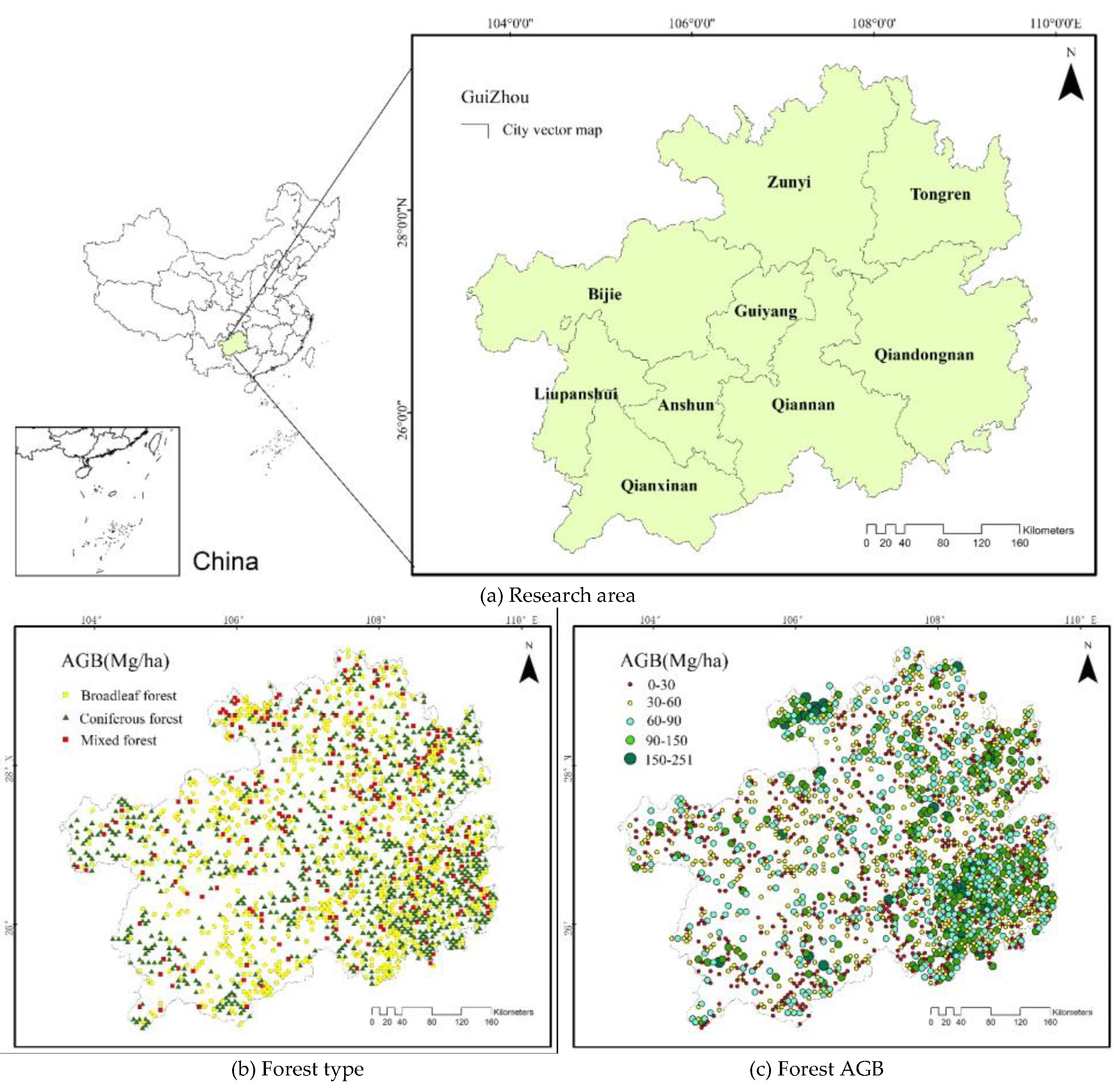

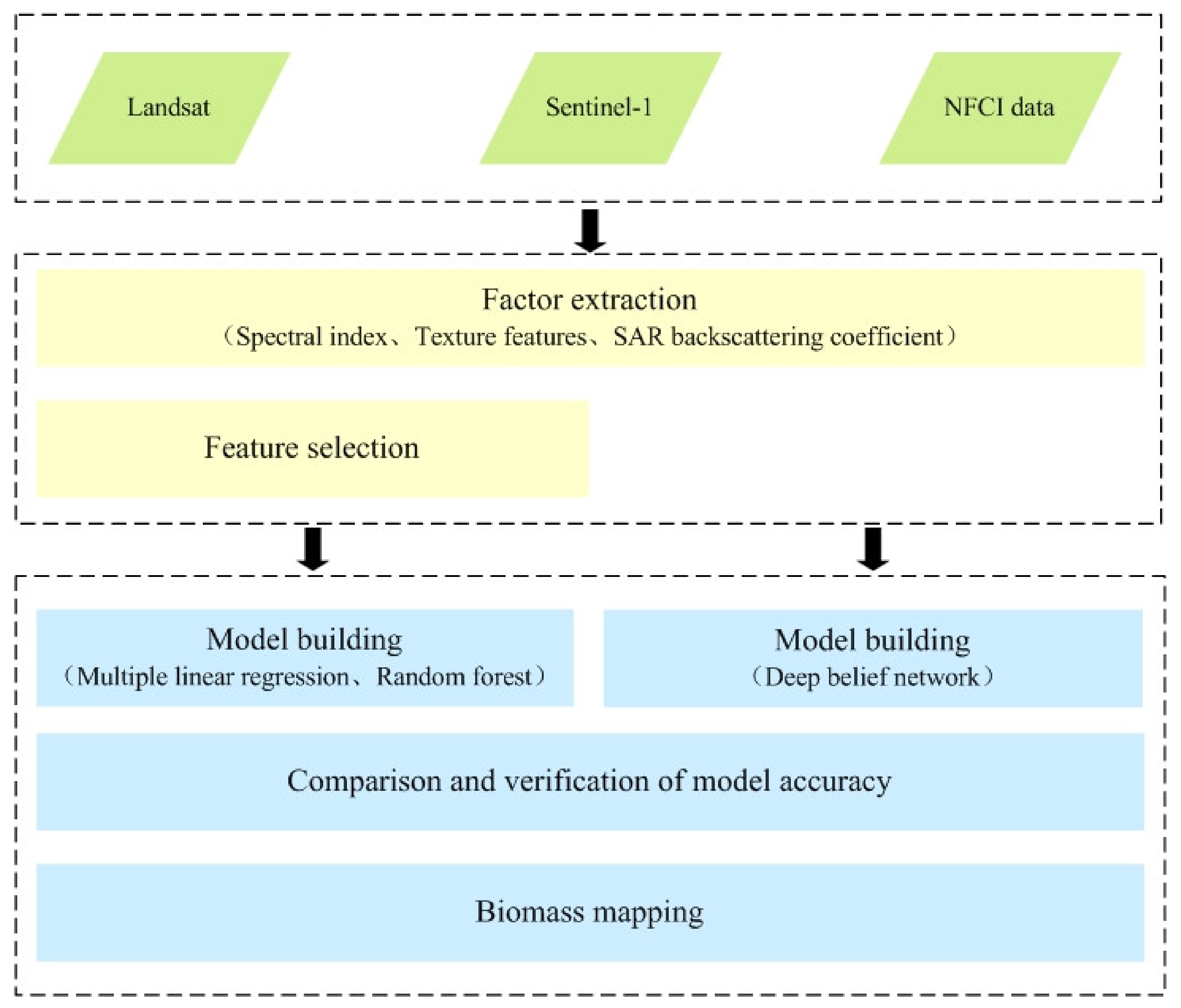
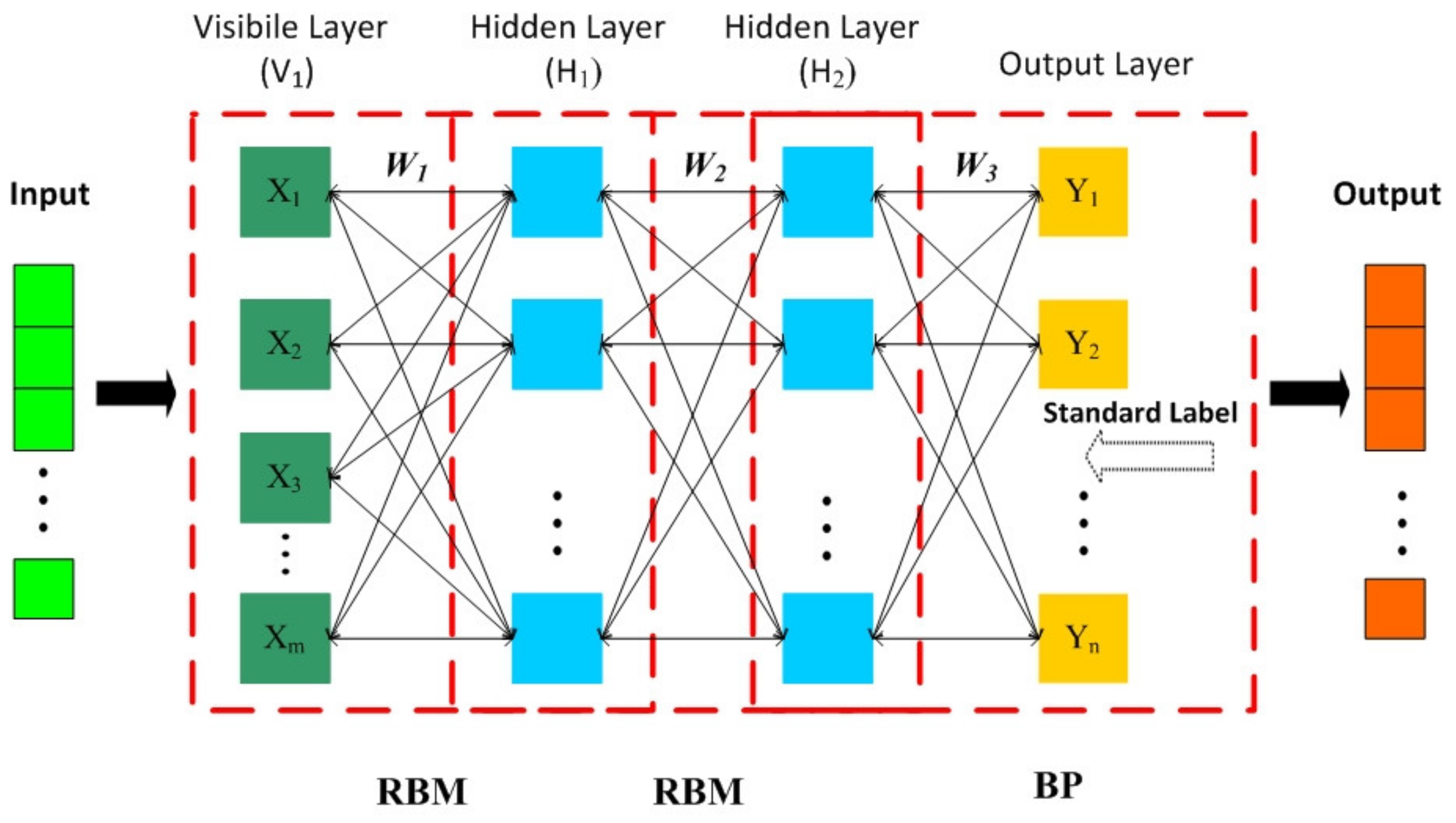
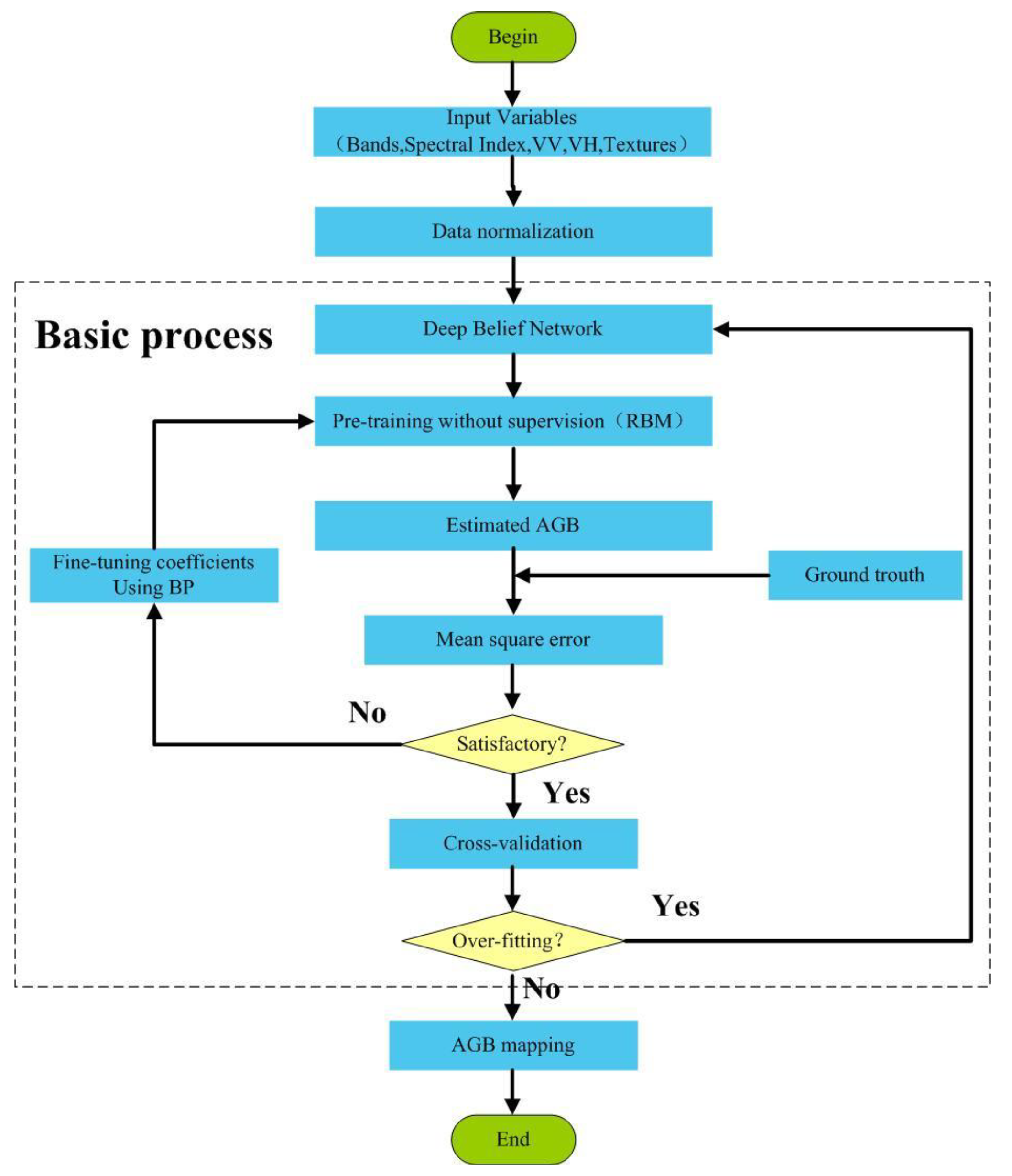
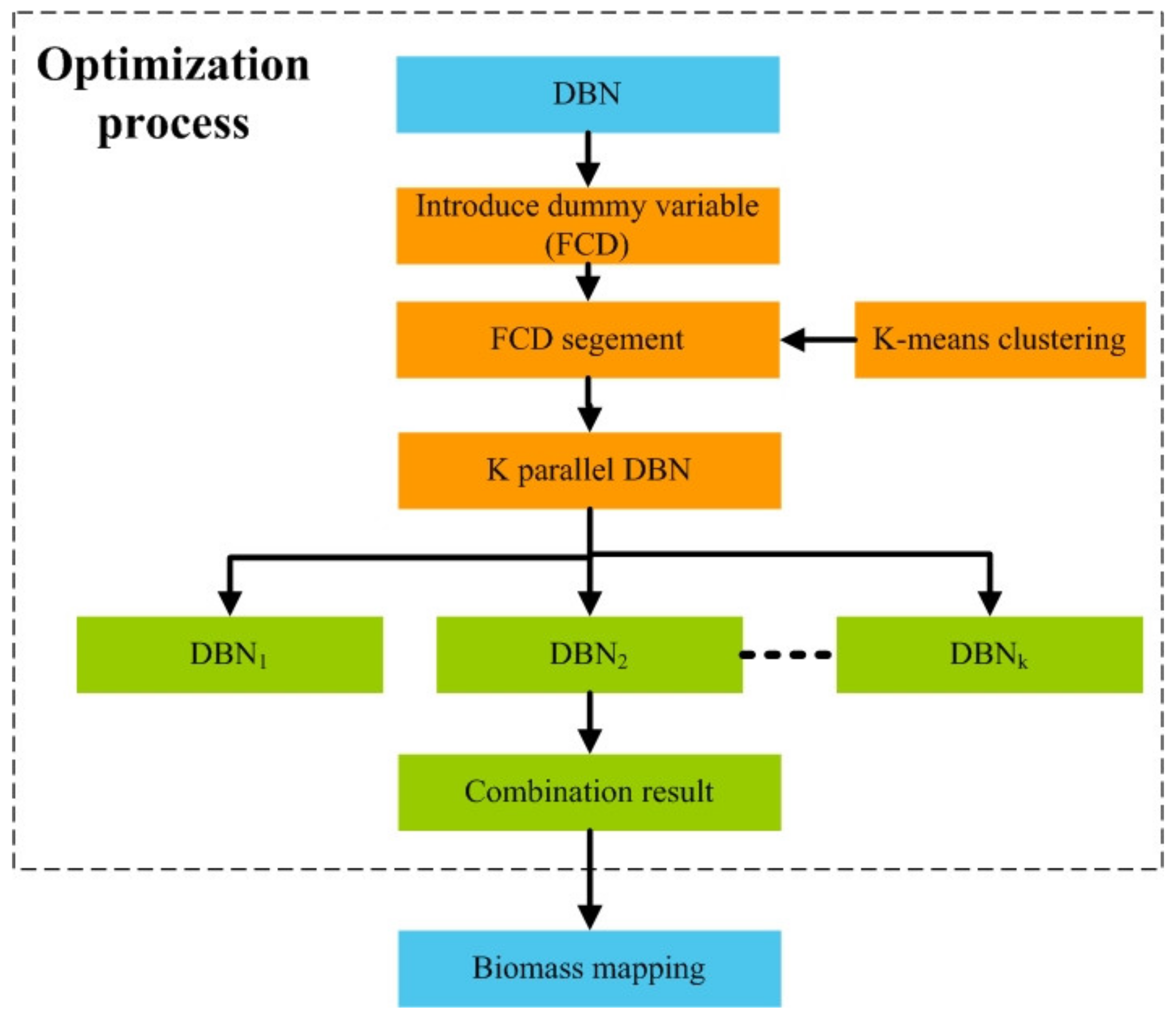


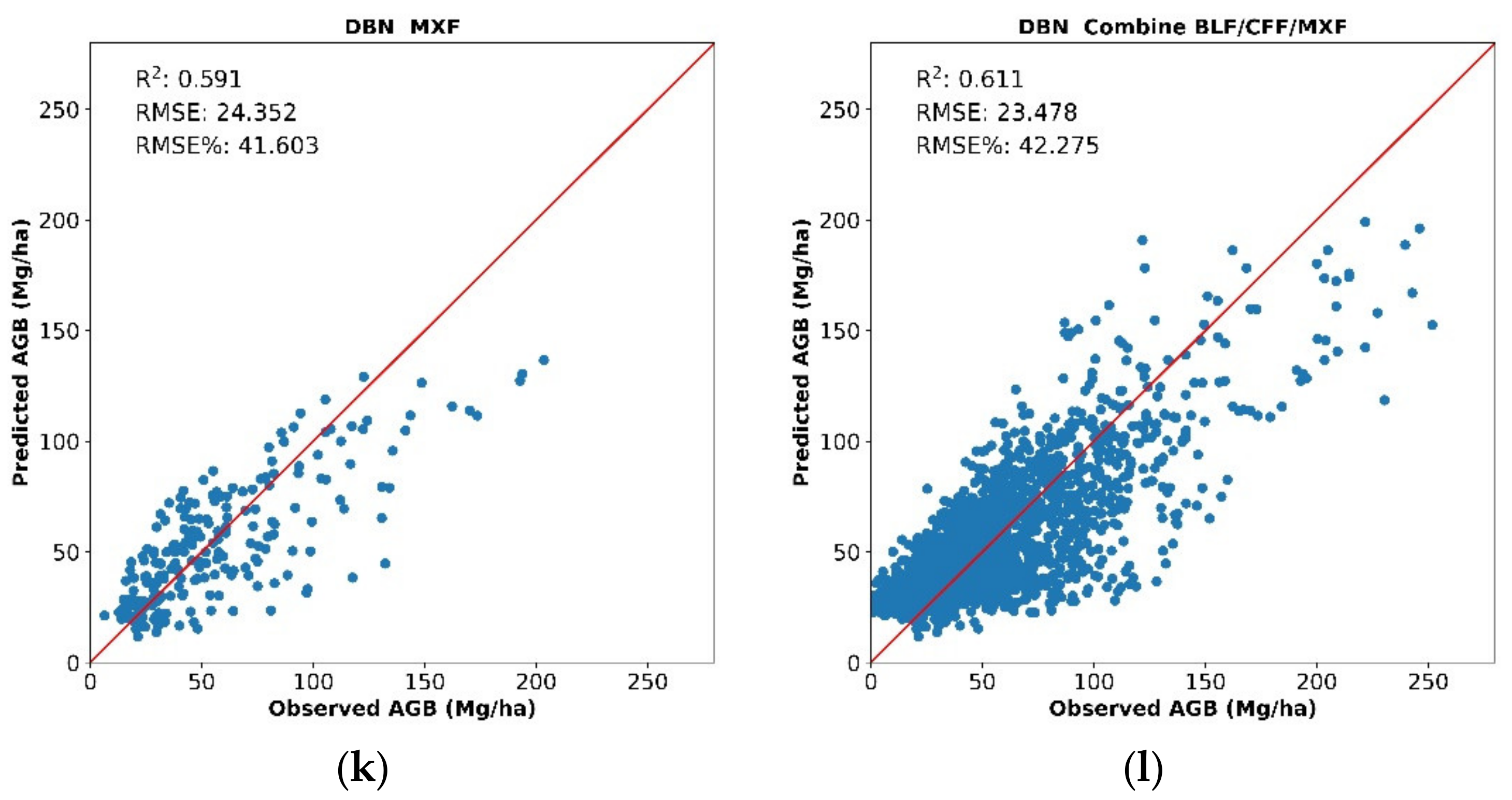

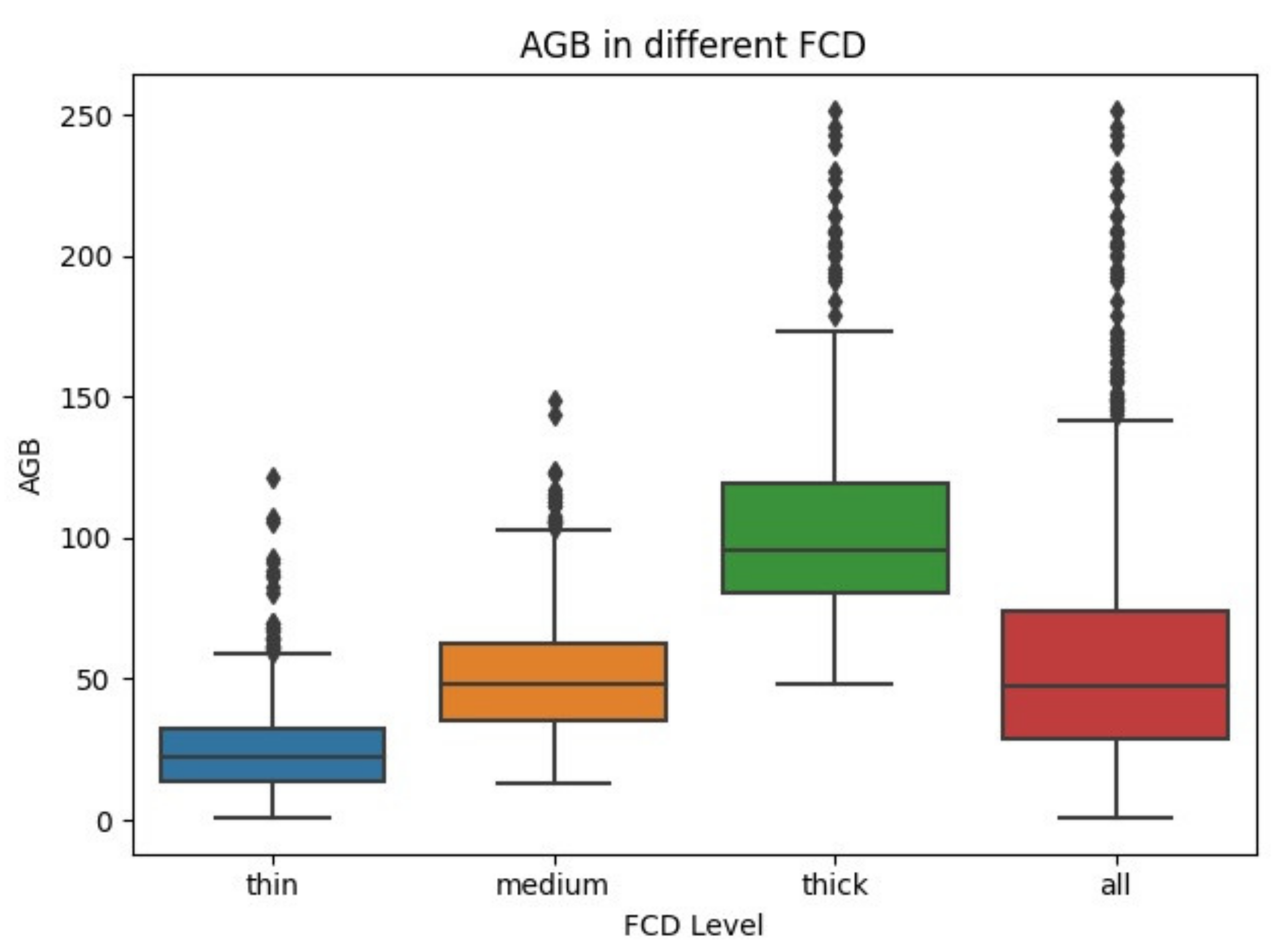
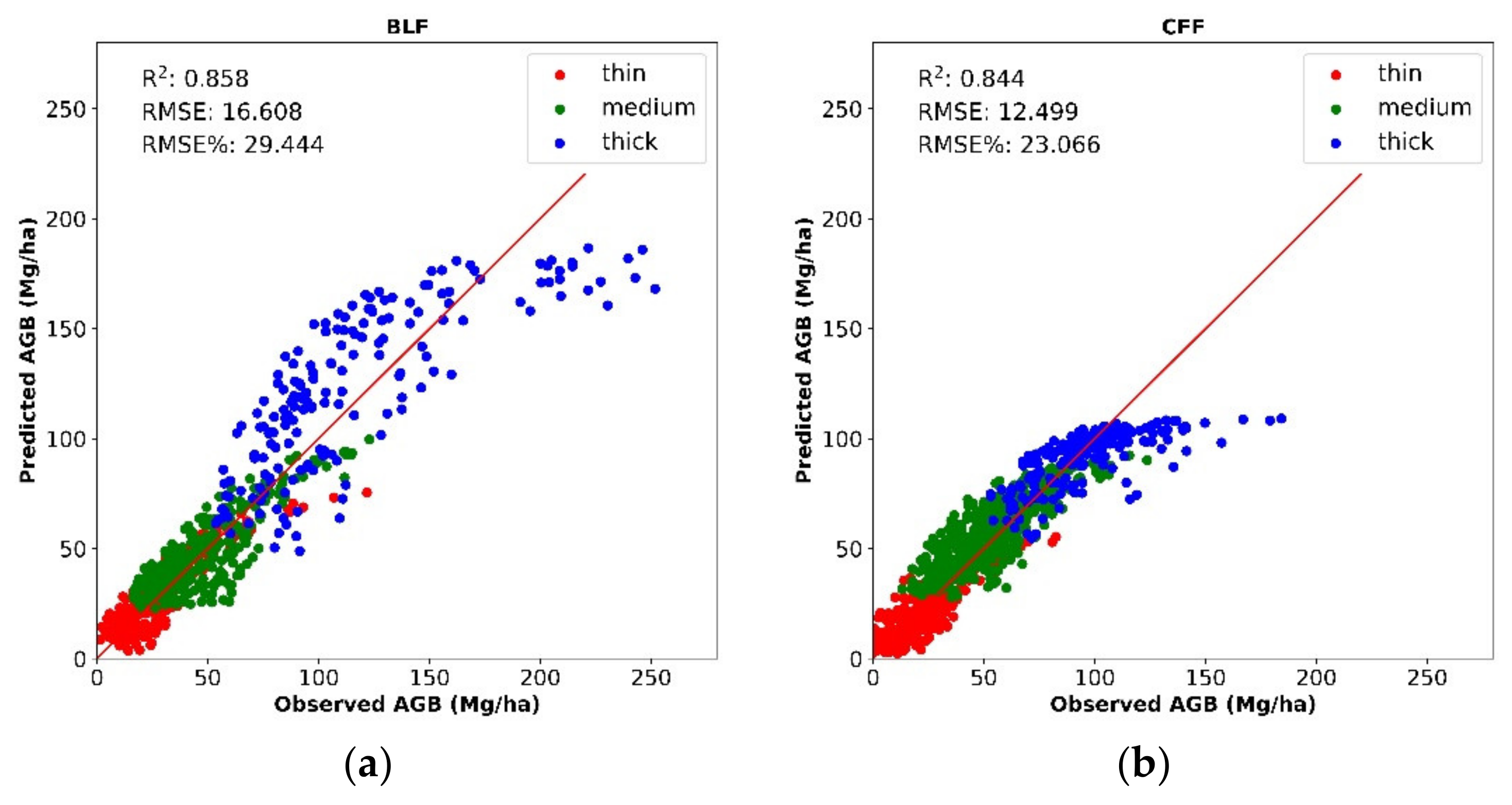
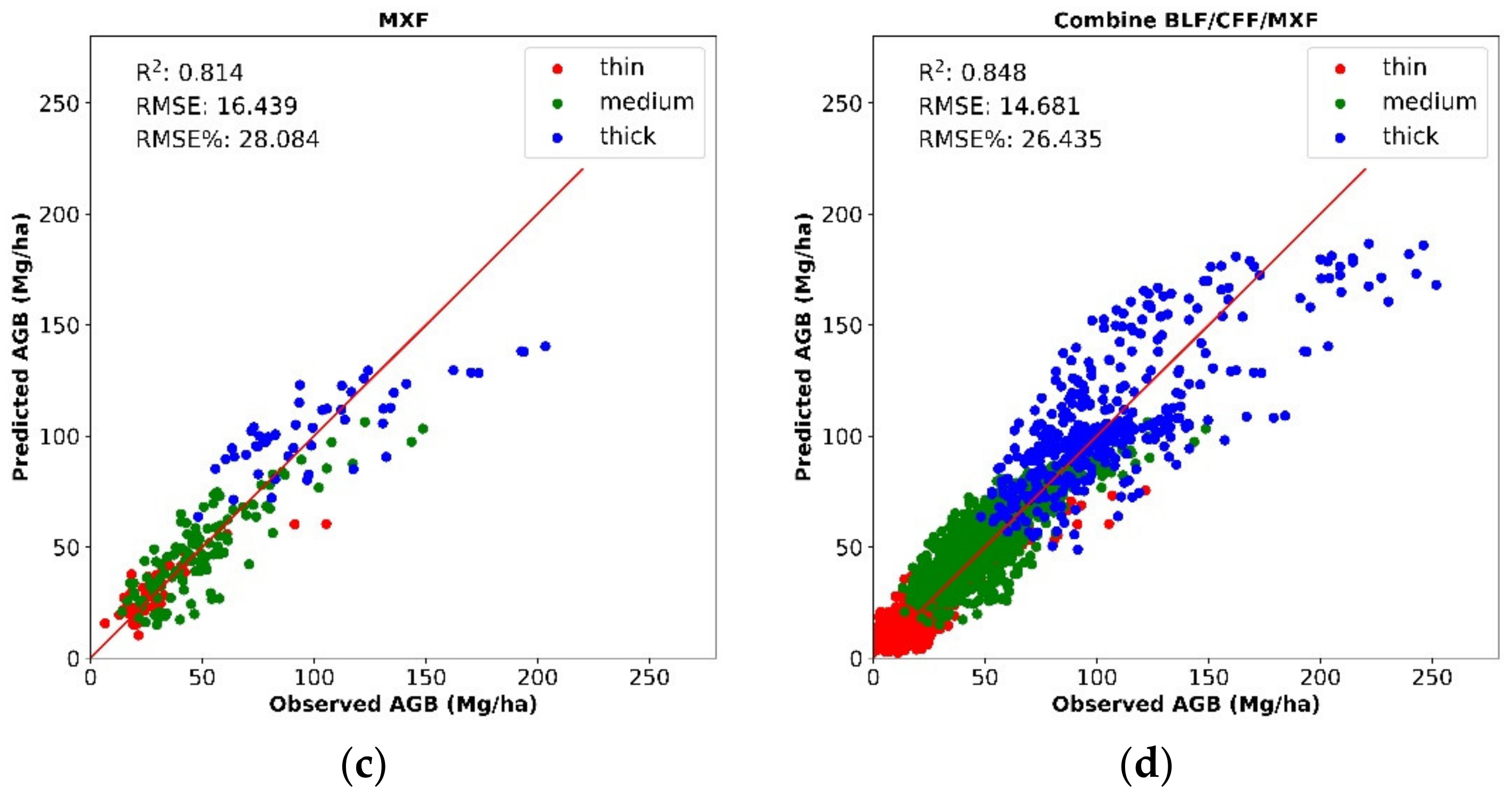


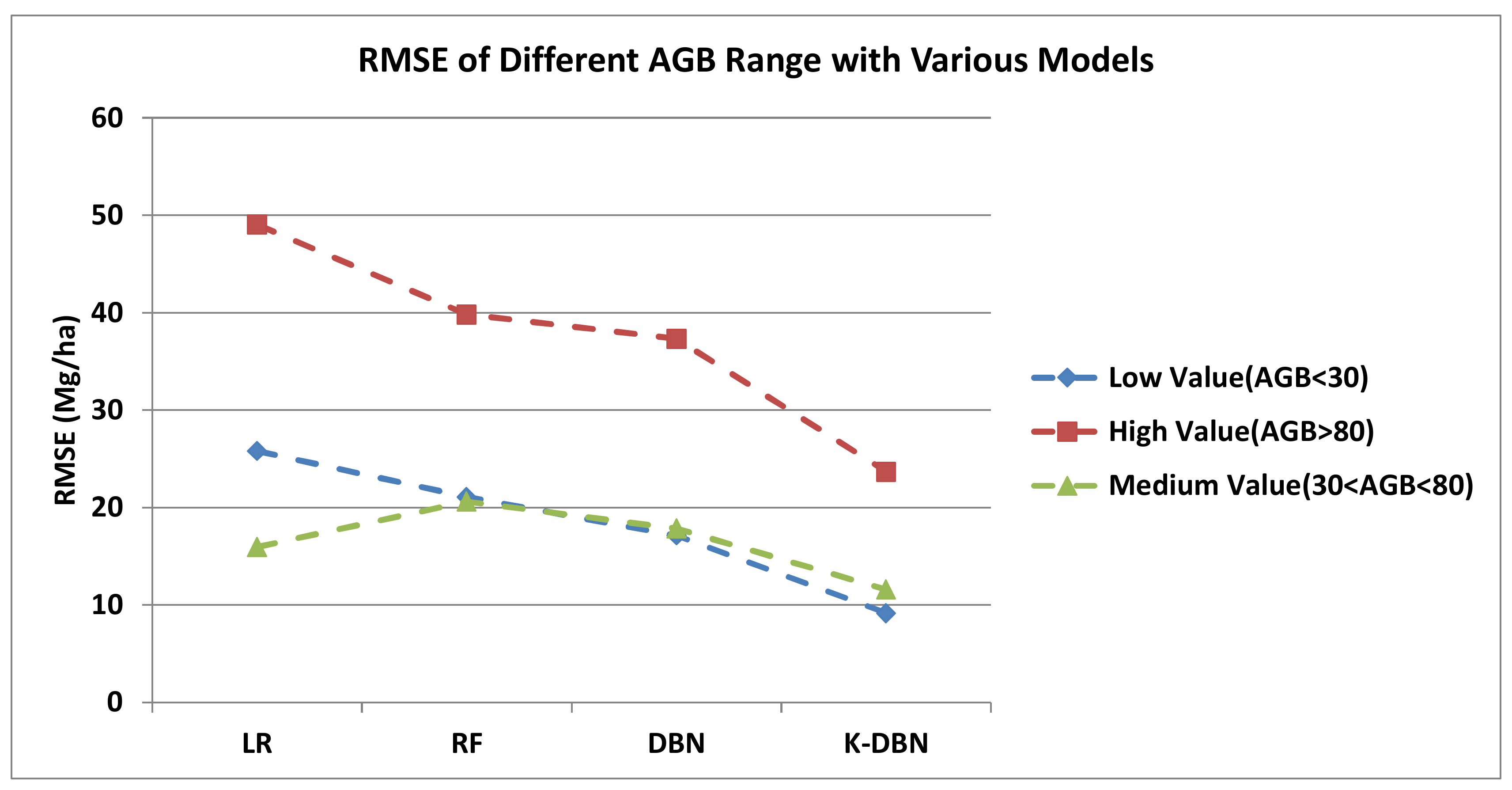
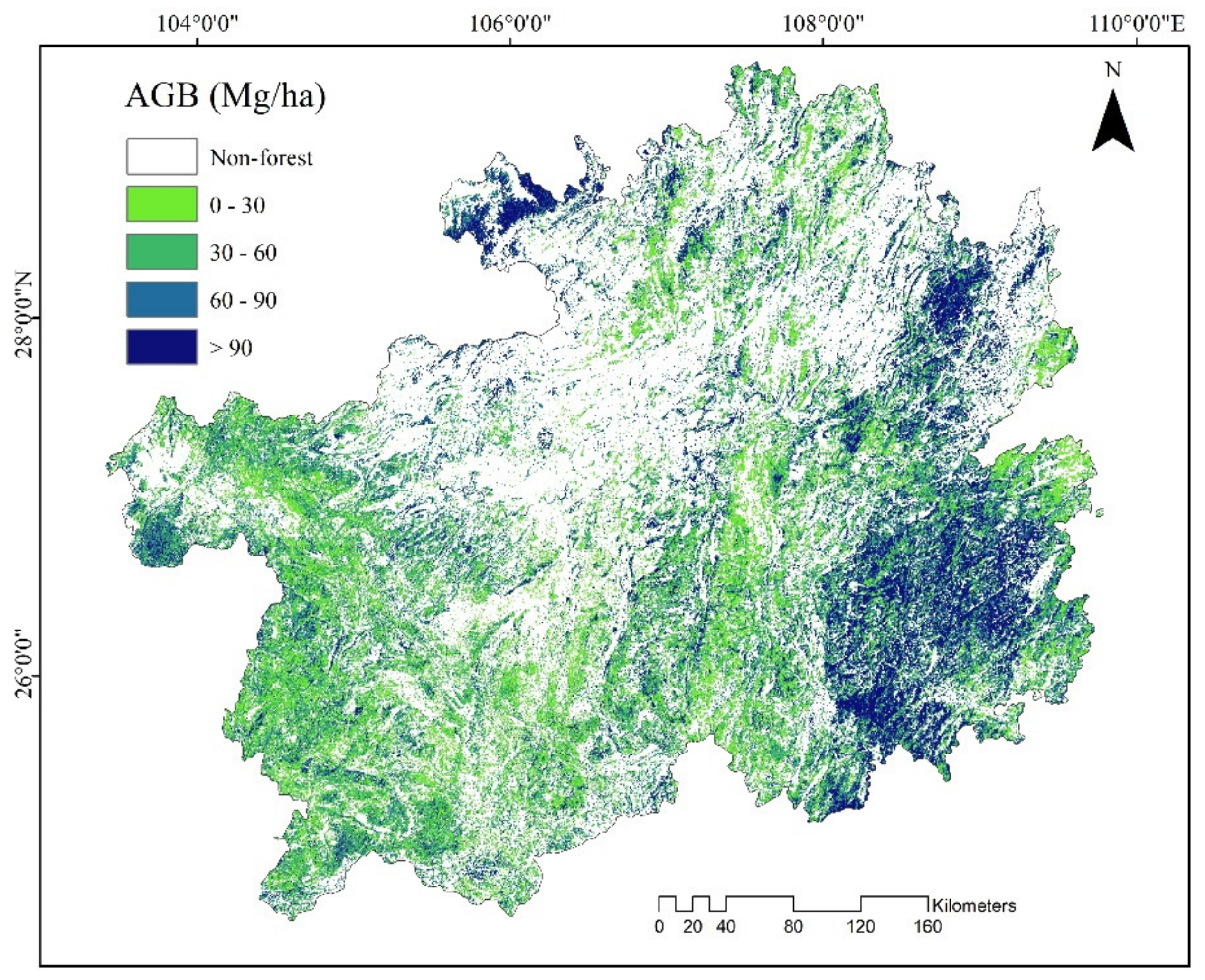
| Forest Type | Number | Min. (Mg/ha) | Max. (Mg/ha) | Mean (Mg/ha) | Std (Mg/ha) | Number of Different AGB Range | ||
|---|---|---|---|---|---|---|---|---|
| <30 Mg/ha | 30–80 Mg/ha | >100 Mg/ha | ||||||
| BLF | 740 | 0.566 | 251.730 | 56.406 | 44.043 | 226 | 346 | 168 |
| CFF | 948 | 1.447 | 184.231 | 54.188 | 31.622 | 246 | 498 | 204 |
| MXF | 212 | 6.389 | 203.470 | 58.534 | 38.072 | 54 | 107 | 51 |
| All | 1900 | 0.566 | 251.730 | 55.537 | 37.661 | 526 | 951 | 423 |
| Forest Type | BLF | CFF | MXF | Other | Producer Accuracy |
|---|---|---|---|---|---|
| BLF | 662 | 58 | 11 | 9 | 0.895 |
| CFF | 62 | 852 | 18 | 16 | 0.899 |
| MXF | 8 | 15 | 185 | 4 | 0.873 |
| User Accuracy | 0.904 | 0.921 | 0.864 |
| Variable Type | Variation Number | Variable Name |
|---|---|---|
| Reflectance | 6 | Band 2,3,4,5,6,7 |
| Vegetation Index | 30 | ARVI CVI DVI EVI GARI GDVI GNDVI GRVI GSAVI IPVI LAI MSRI MSAVI2 NDVI NLI OSAVI RDVI RVI SAVI SLAVI SR TCA TCD TCDI TGI VARI TCW TCG TCB TDVI |
| Texture feature | 144 | GLCM |
| Sentinel-1A | 2 | VV VH |
| 48 | GLCM |
| Parameters | R2 | |||
|---|---|---|---|---|
| BLF | CFF | MXF | ||
| Number of hidden layers (set iterations 50) | 1 (50) | 0.5784 | 0.5064 | 0.5618 |
| 2 (50-50) | 0.5960 | 0.5240 | 0.5696 | |
| 3 (50-50-50) | 0.6002 | 0.5326 | 0.5768 | |
| 4 (50-50-50-50) | 0.5945 | 0.5255 | 0.5677 | |
| 5 (50-50-50-50-50) | 0.5531 | 0.4991 | 0.5565 | |
| Number of hidden knots (set iterations 50) | 90-90-90 | 0.5798 | 0.5193 | 0.5582 |
| 80-80-80 | 0.6032 | 0.5361 | 0.5558 | |
| 70-70-70 | 0.6141 | 0.5471 | 0.5632 | |
| 60-60-60 | 0.6082 | 0.5443 | 0.5666 | |
| 50-50-50 | 0.6002 | 0.5326 | 0.5768 | |
| 40-40-40 | 0.5958 | 0.5317 | 0.5642 | |
| 30-30-30 | 0.5822 | 0.5287 | 0.5518 | |
| Number of iterations | 20 | 0.5993 | 0.5228 | 0.5543 |
| 50 | 0.6141 | 0.5471 | 0.5768 | |
| 100 | 0.6279 | 0.5592 | 0.5913 | |
| 200 | 0.6401 | 0.5728 | 0.5887 | |
| 400 | 0.6357 | 0.5685 | 0.5824 | |
| 600 | 0.6326 | 0.5657 | 0.5762 | |
| 800 | 0.6390 | 0.5533 | 0.5705 | |
| Forest Type | FCD level | Number of Samples | Max. | Min. | Mean | Std |
|---|---|---|---|---|---|---|
| (Mg/ha) | ||||||
| BLF | thin | 245 | 121.744 | 0.566 | 26.610 | 18.948 |
| medium | 322 | 122.889 | 16.670 | 47.440 | 20.764 | |
| thick | 173 | 251.730 | 53.656 | 115.292 | 46.216 | |
| CFF | thin | 256 | 82.476 | 1.447 | 23.688 | 15.132 |
| medium | 498 | 123.612 | 13.119 | 53.522 | 20.123 | |
| thick | 194 | 184.231 | 52.973 | 96.142 | 23.576 | |
| MXF | thin | 45 | 105.421 | 6.389 | 29.517 | 17.907 |
| medium | 118 | 148.592 | 14.075 | 50.379 | 25.053 | |
| thick | 49 | 203.470 | 48.199 | 104.822 | 37.273 | |
Publisher’s Note: MDPI stays neutral with regard to jurisdictional claims in published maps and institutional affiliations. |
© 2021 by the authors. Licensee MDPI, Basel, Switzerland. This article is an open access article distributed under the terms and conditions of the Creative Commons Attribution (CC BY) license (https://creativecommons.org/licenses/by/4.0/).
Share and Cite
Qian, C.; Qiang, H.; Wang, F.; Li, M. Estimation of Forest Aboveground Biomass in Karst Areas Using Multi-Source Remote Sensing Data and the K-DBN Algorithm. Remote Sens. 2021, 13, 5030. https://doi.org/10.3390/rs13245030
Qian C, Qiang H, Wang F, Li M. Estimation of Forest Aboveground Biomass in Karst Areas Using Multi-Source Remote Sensing Data and the K-DBN Algorithm. Remote Sensing. 2021; 13(24):5030. https://doi.org/10.3390/rs13245030
Chicago/Turabian StyleQian, Chunhua, Hequn Qiang, Feng Wang, and Mingyang Li. 2021. "Estimation of Forest Aboveground Biomass in Karst Areas Using Multi-Source Remote Sensing Data and the K-DBN Algorithm" Remote Sensing 13, no. 24: 5030. https://doi.org/10.3390/rs13245030
APA StyleQian, C., Qiang, H., Wang, F., & Li, M. (2021). Estimation of Forest Aboveground Biomass in Karst Areas Using Multi-Source Remote Sensing Data and the K-DBN Algorithm. Remote Sensing, 13(24), 5030. https://doi.org/10.3390/rs13245030







